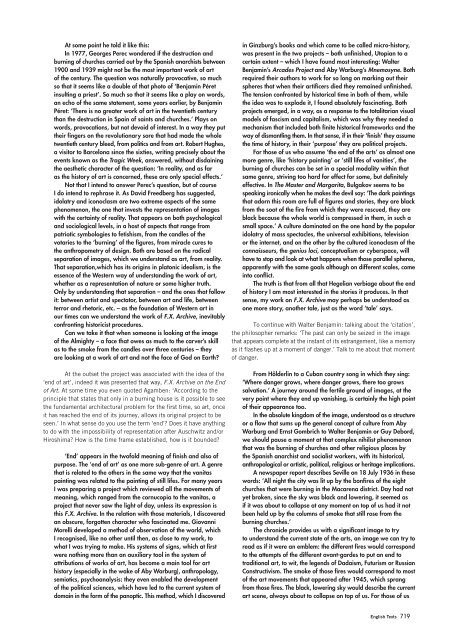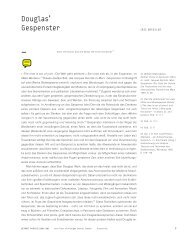English Texts
English Texts
English Texts
Create successful ePaper yourself
Turn your PDF publications into a flip-book with our unique Google optimized e-Paper software.
At some point he told it like this:<br />
In 1977, Georges Perec wondered if the destruction and<br />
burning of churches carried out by the Spanish anarchists between<br />
1900 and 1939 might not be the most important work of art<br />
of the century. The question was naturally provocative, so much<br />
so that it seems like a double of that photo of ‘Benjamin Péret<br />
insulting a priest’. So much so that it seems like a play on words,<br />
an echo of the same statement, some years earlier, by Benjamin<br />
Péret: ‘There is no greater work of art in the twentieth century<br />
than the destruction in Spain of saints and churches.’ Plays on<br />
words, provocations, but not devoid of interest. In a way they put<br />
their fingers on the revolutionary sore that had made the whole<br />
twentieth century bleed, from politics and from art. Robert Hughes,<br />
a visitor to Barcelona since the sixties, writing precisely about the<br />
events known as the Tragic Week, answered, without disdaining<br />
the aesthetic character of the question: ‘In reality, and as far<br />
as the history of art is concerned, these are only special effects.’<br />
Not that I intend to answer Perec’s question, but of course<br />
I do intend to rephrase it. As David Freedberg has suggested,<br />
idolatry and iconoclasm are two extreme aspects of the same<br />
phenomenon, the one that invests the representation of images<br />
with the certainty of reality. That appears on both psychological<br />
and sociological levels, in a host of aspects that range from<br />
patriotic symbologies to fetishism, from the candles of the<br />
votaries to the ‘burning’ of the figures, from miracle cures to<br />
the anthropometry of design. Both are based on the radical<br />
separation of images, which we understand as art, from reality.<br />
That separation,which has its origins in platonic idealism, is the<br />
essence of the Western way of understanding the work of art,<br />
whether as a representation of nature or some higher truth.<br />
Only by understanding that separation – and the ones that follow<br />
it: between artist and spectator, between art and life, between<br />
terror and rhetoric, etc. – as the foundation of Western art in<br />
our times can we understand the work of F.X. Archive, inevitably<br />
confronting historicist procedures.<br />
Can we take it that when someone is looking at the image<br />
of the Almighty – a face that owes as much to the carver’s skill<br />
as to the smoke from the candles over three centuries – they<br />
are looking at a work of art and not the face of God on Earth?<br />
At the outset the project was associated with the idea of the<br />
‘end of art’, indeed it was presented that way, F.X. Archive on the End<br />
of Art. At some time you even quoted Agamben: ‘According to the<br />
principle that states that only in a burning house is it possible to see<br />
the fundamental architectural problem for the first time, so art, once<br />
it has reached the end of its journey, allows its original project to be<br />
seen.’ In what sense do you use the term ‘end’? Does it have anything<br />
to do with the impossibility of representation after Auschwitz and/or<br />
Hiroshima? How is the time frame established, how is it bounded?<br />
‘End’ appears in the twofold meaning of finish and also of<br />
purpose. The ‘end of art’ as one more sub-genre of art. A genre<br />
that is related to the others in the same way that the vanitas<br />
painting was related to the painting of still lifes. For many years<br />
I was preparing a project which reviewed all the movements of<br />
meaning, which ranged from the cornucopia to the vanitas, a<br />
project that never saw the light of day, unless its expression is<br />
this F.X. Archive. In the relation with those materials, I discovered<br />
an obscure, forgotten character who fascinated me. Giovanni<br />
Morelli developed a method of observation of the world, which<br />
I recognised, like no other until then, as close to my work, to<br />
what I was trying to make. His systems of signs, which at first<br />
were nothing more than an auxiliary tool in the system of<br />
attributions of works of art, has become a main tool for art<br />
history (especially in the wake of Aby Warburg), anthropology,<br />
semiotics, psychoanalysis: they even enabled the development<br />
of the political sciences, which have led to the current system of<br />
domain in the form of the panoptic. This method, which I discovered<br />
in Ginzburg’s books and which came to be called micro-history,<br />
was present in the two projects – both unfinished, Utopian to a<br />
certain extent – which I have found most interesting: Walter<br />
Benjamin’s Arcades Project and Aby Warburg’s Mnemosyne. Both<br />
required their authors to work for so long on marking out their<br />
spheres that when their artificers died they remained unfinished.<br />
The tension confronted by historical time in both of them, while<br />
the idea was to explode it, I found absolutely fascinating. Both<br />
projects emerged, in a way, as a response to the totalitarian visual<br />
models of fascism and capitalism, which was why they needed a<br />
mechanism that included both finite historical frameworks and the<br />
way of dismantling them. In that sense, if in their ‘finish’ they assume<br />
the time of history, in their ‘purpose’ they are political projects.<br />
For those of us who assume ‘the end of the arts’ as almost one<br />
more genre, like ‘history painting’ or ‘still lifes of vanities’, the<br />
burning of churches can be set in a special modality within that<br />
same genre, striving too hard for effect for some, but definitely<br />
effective. In The Master and Margarita, Bulgakov seems to be<br />
speaking ironically when he makes the devil say: ‘The dark paintings<br />
that adorn this room are full of figures and stories, they are black<br />
from the soot of the fire from which they were rescued, they are<br />
black because the whole world is compressed in them, in such a<br />
small space.’ A culture dominated on the one hand by the popular<br />
idolatry of mass spectacles, the universal exhibitions, television<br />
or the internet, and on the other by the cultured iconoclasm of the<br />
connaisseurs, the genius loci, conceptualism or cyberspace, will<br />
have to stop and look at what happens when those parallel spheres,<br />
apparently with the same goals although on different scales, come<br />
into conflict.<br />
The truth is that from all that Hegelian verbiage about the end<br />
of history I am most interested in the stories it produces. In that<br />
sense, my work on F.X. Archive may perhaps be understood as<br />
one more story, another tale, just as the word ‘tale’ says.<br />
To continue with Walter Benjamin: talking about the ‘citation’,<br />
the philosopher remarks: ‘The past can only be seized in the image<br />
that appears complete at the instant of its estrangement, like a memory<br />
as it flashes up at a moment of danger.’ Talk to me about that moment<br />
of danger.<br />
From Hölderlin to a Cuban country song in which they sing:<br />
‘Where danger grows, where danger grows, there too grows<br />
salvation.’ A journey around the fertile ground of images, at the<br />
very point where they end up vanishing, is certainly the high point<br />
of their appearance too.<br />
In the absolute kingdom of the image, understood as a structure<br />
or a flow that sums up the general concept of culture from Aby<br />
Warburg and Ernst Gombrich to Walter Benjamin or Guy Debord,<br />
we should pause a moment at that complex nihilist phenomenon<br />
that was the burning of churches and other religious places by<br />
the Spanish anarchist and socialist workers, with its historical,<br />
anthropological or artistic, political, religious or heritage implications.<br />
A newspaper report describes Seville on 18 July 1936 in these<br />
words: ‘All night the city was lit up by the bonfires of the eight<br />
churches that were burning in the Macarena district. Day had not<br />
yet broken, since the sky was black and lowering, it seemed as<br />
if it was about to collapse at any moment on top of us had it not<br />
been held up by the columns of smoke that still rose from the<br />
burning churches.’<br />
The chronicle provides us with a significant image to try<br />
to understand the current state of the arts, an image we can try to<br />
read as if it were an emblem: the different fires would correspond<br />
to the attempts of the different avant-gardes to put an end to<br />
traditional art, to wit, the legends of Dadaism, Futurism or Russian<br />
Constructivism. The smoke of those fires would correspond to most<br />
of the art movements that appeared after 1945, which sprang<br />
from those fires. The black, lowering sky would describe the current<br />
art scene, always about to collapse on top of us. For those of us<br />
<strong>English</strong> <strong>Texts</strong> 719










